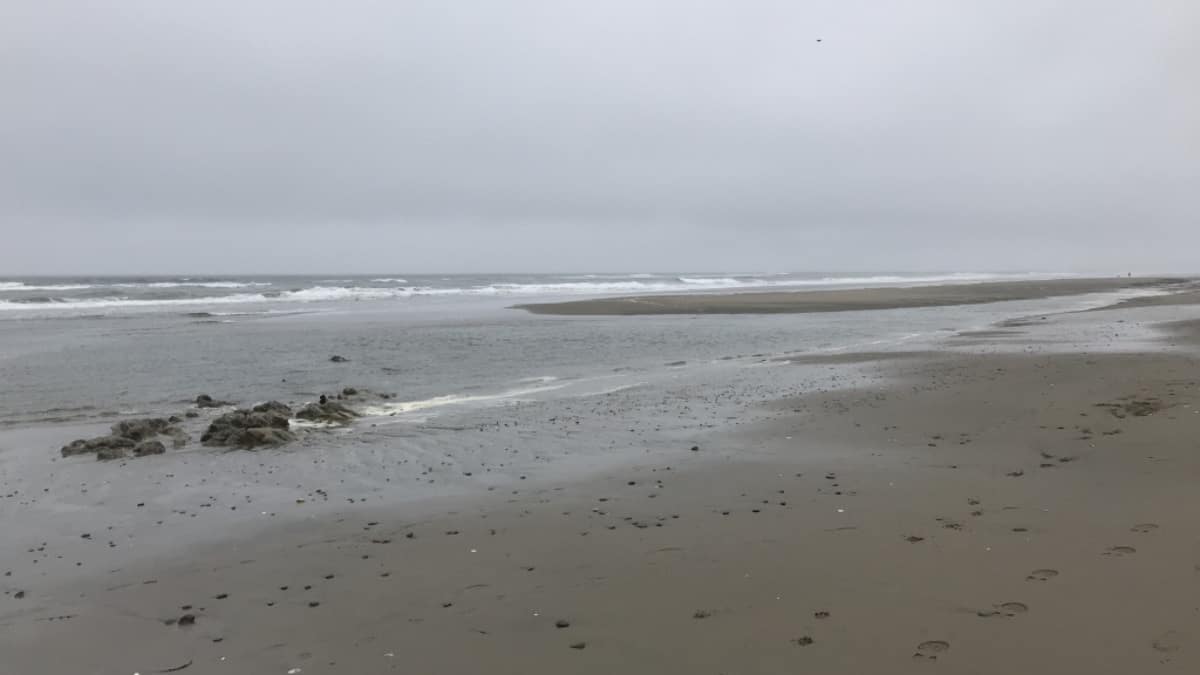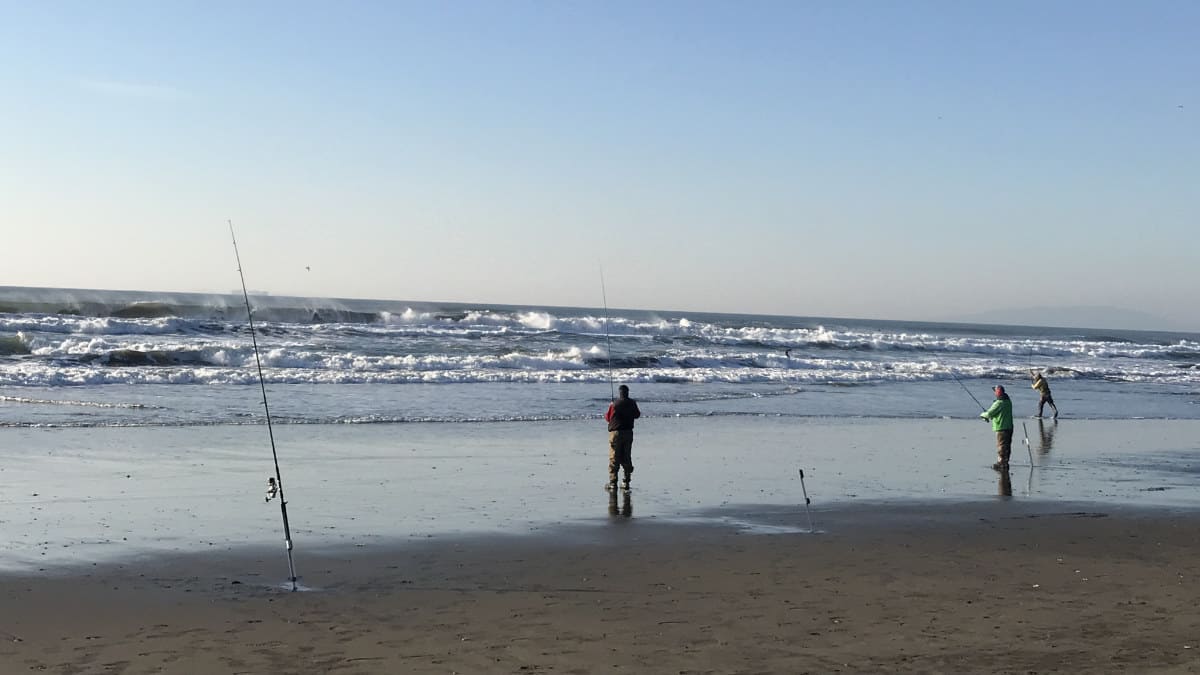Surf fishing is a deceptively complicated hobby. Many surf fishing hobbyists love to cast their line as far as they can. And it’s hard to blame them ‒ it’s pretty fun to see how long your cast can go. But despite its appeal, a long-distance cast isn’t always the best choice.
So, how far should you cast when surf fishing? You should cast as far as you need to in order to access the areas with the most fish. Contrary to popular belief, you don’t always want to cast your line as far as possible. It’s best to identify where the fish are feeding and aim your cast accordingly.
When I got into surf fishing![]() , I wasn’t really sure how far I should cast. To figure it out, I did a bit of research. Here’s what I found.
, I wasn’t really sure how far I should cast. To figure it out, I did a bit of research. Here’s what I found.
How Far Should You Cast To Catch Fish From The Surf?
Deciding how far to cast from the surf can be a daunting task at first glance. However, there are a few tricks you can use to determine the best casting distance.
Locate the sand bars
The best way to hone in on a good casting distance is to find the sand bars hidden under the waves. Fish like to gather in two places: the shallow trough between the shore and the sand bar, and the deeper trough beyond the sandbar. Check this article to learn how to find the best spot for surf fishing.![]()
Although you can try waiting for low tide to see the exposed sand bars, this isn’t actually necessary. You don’t have to wait for low tide to find them ‒ just look at where the waves are breaking.
Wherever whitecaps start forming, there’s a high likelihood that there’s a sandbar underneath them. Try casting a bit before and a bit beyond the point of wave breakage ‒ chances are, you’ll start getting some bites.
The trial and error method
While using the sandbars to find a good cast distance is a smart idea, it’s not always possible. If the seas are too calm, you can’t find the sandbars because the waves won’t be breaking on them.
On the flip side, if the seas are too rough, you can’t find the sandbars because the wind will be causing whitecaps to form well beyond the sandbar breakpoint.
In these instances, your best bet is to use what I call the trial and error method.
It’s pretty simple. Choose a direction, cast as far as you can, and slowly reel in. If you get a bite, make a note of where you got that bite and continue casting in that spot.
If you don’t get anything, turn to the left or right a bit and cast again. If you don’t get a bite after 3-5 casts, walk down the shoreline a bit and do the whole thing over again.
One more thing: while casting as far as possible can be helpful here, it isn’t necessary. I often find success casting right behind where the waves break.
How to find where the fish are feeding
Your first order of business when starting a day of surf fishing should be to figure out where the fish are congregating. Casting your line in any old direction is fine if you don’t care about catching much fish.
However, if you’re serious about the time you spend surf fishing, you need to target the spots most likely to have fish in them.
Find patches of brown water
The first way to identify a likely fish feeding ground is by spotting a brown patch of water. Brown water is created by heavy surf tearing up the seafloor.
Fish often flock to these areas because the waves bring tasty crustaceans and other sources of food to the surface of the seafloor.
While it’s a useful marker, brown water doesn’t always indicate an abundance of fish though. Some areas of the seafloor simply lack the sea-life most fish want to eat.
If a rough spree of waves rolls over one of these relatively lifeless areas, the fish will ignore it because there won’t be many meals brought up with the sand and mud.
Look for birds or fish in a feeding frenzy
The most obvious sign that fish are present in a particular spot is dive-bombing birds or surface-breaching fish feeding in a single area.
The bigger fish that you’re after are eating smaller fish, and the birds are trying to catch whatever they can find. When you see this happening, drop whatever you’re doing and cast a line out as quickly as possible.
You’re virtually guaranteed a catch when a feeding frenzy happens ‒ just be careful not to reel in a bird by mistake.
Do a tide survey
If none of the obvious signs of fish are present, the best way to identify spots ![]() with a higher density of fish is to perform a topological survey when the tide is low.
with a higher density of fish is to perform a topological survey when the tide is low.

Performing a tide survey is a simple and leisurely activity: you walk down the shoreline and make a note of anything on the exposed seafloor that might attract fish.
Here are some of the things you should look for when performing a tide survey:
- Signs of life: worms, mussels, cockles, crabs, etc.
- Seaweed patches ‒ smaller fish like to hide in these, which will attract larger fish.
- Rock formations ‒ another popular hiding spot.
- Signs of a rougher seafloor ‒ rocks, pebbles, mud, etc. Fish are more attracted to this type of ground than they are smooth sand.
- Hollows or divots in the seafloor ‒ these are also popular hiding spots
If you’re having trouble locating rougher patches of the seafloor, try casting a line with only a weight attached. As you reel it in, the differences in the vibrations should tell you if the seabed changes from sand to rock, or vice-versa.
Finally, make a mental note of any interesting locations you find. Look behind you and identify any physical landmarks that can help you find your way back to these fish-rich locations.
If possible, place a mark in the sand ‒ above the high tide line ‒ that you can easily find later on.
Look for other surf fishermen congregating in one area
If you see other surf anglers fixated on one spot, there’s a good chance they know something you don’t. Don’t be afraid to walk over and ask why they’re fishing in this area.
If they tell you they’ve seen signs of fish activity, or that they’ve done a tide survey and thought this spot was promising, cast a line and see what happens.
Ask the local bait shop
Bait shops are a treasure trove of information for location-centric fishing advice. The people who work in these stores are usually avid fishers themselves, and most will be happy to share their favorite spots along the shoreline.
They can also recommend specific types of bait that the fish in the area prefer, which is extremely helpful if you’re on vacation and unfamiliar with the local fishing population.
Look for rip currents
Swimmers should avoid rip currents at all costs ‒ but surf fishers should flock to them like children to candy. Also known as outflows, these powerful currents are caused by breaks in the sand bar, and fish love to feed in these environments.
If you find a rip current, try casting your line to the left or right of the current’s flow. Fish often feed on the edges of rip currents, so targeting the sides can give you a higher catch rate. Learn how to read the beach.![]()
Work with the weather and tides
The last tip I have for finding the best surf fishing locations is to use the weather and tides to your advantage.
Fish typically come in to feed in the two hours leading up to high tide and the two hours following high tide. This often makes a worthwhile surf fishing outing take all day ‒ you may need to do a tide survey at low tide and only start catching fish once the tide nears its high mark.
While not necessarily related to finding a good fishing location, surf fishing while it’s cloudy can actually help you catch more fish.
The overcast will keep the shadows from your line at a minimum, which will entice more fish to snap on your bait.
Summary
Finding the right cast distance can be surprisingly difficult. To make the process a bit easier, you can take the following steps to identify the spots that most likely have an abundance of fish:
- Locate the sand bars.
- Use the trial and error method.
- Find patches of brown water.
- Look for birds or fish in a feeding frenzy.
- Do a tide survey.
- Look for other surf fishermen.
- Ask the local bait shop.
- Look for rip currents.
- Use the weather and tides.

